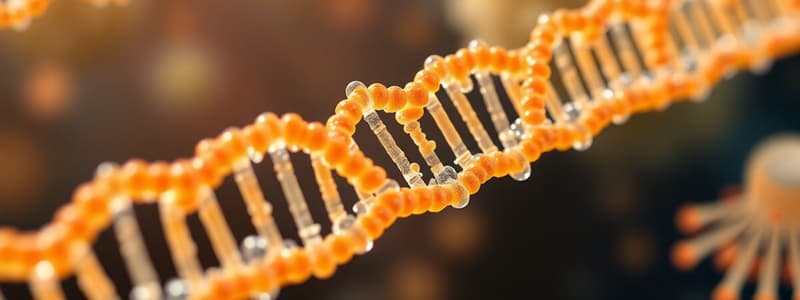Podcast
Questions and Answers
What type of organic polymers do bacteria and archaea produce for carbon storage?
What type of organic polymers do bacteria and archaea produce for carbon storage?
- Polystyrene
- Polyethylene glycol
- Polyhydroxyalkanoates (correct)
- Polyethylene
What is a primary challenge encountered in using bacterial strains for PHA production?
What is a primary challenge encountered in using bacterial strains for PHA production?
- Low production rates
- Lack of suitable bacteria
- High carbon availability
- High feeding costs (correct)
What resource requirement sets the alga-based system apart for PHB production?
What resource requirement sets the alga-based system apart for PHB production?
- Requires freshwater sources
- Requires sunlight and CO₂ (correct)
- Requires artificial fertilizers
- Requires complex nutrient solutions
Which alga is specifically being considered for genetic modification to enhance PHB production?
Which alga is specifically being considered for genetic modification to enhance PHB production?
What was one outcome of the 2011 demonstration regarding the diatom-based PHB production?
What was one outcome of the 2011 demonstration regarding the diatom-based PHB production?
What remains a necessary step in maximizing PHB production in eukaryotic systems?
What remains a necessary step in maximizing PHB production in eukaryotic systems?
What is a primary concern when considering gene transfer for PHA synthesis into plants?
What is a primary concern when considering gene transfer for PHA synthesis into plants?
What contributes to the high costs associated with microbe-derived PHA production?
What contributes to the high costs associated with microbe-derived PHA production?
Flashcards
What are PHAs?
What are PHAs?
Polyhydroxyalkanoates (PHAs) are a type of polyester produced by bacteria and archaea as a carbon storage mechanism.
How do microbes use PHAs?
How do microbes use PHAs?
Microbes synthesize PHAs when carbon is limited and degrade them when carbon is abundant.
Why are PHAs interesting for plastic production?
Why are PHAs interesting for plastic production?
The production of PHAs by microbes is promising for sustainable plastic production because it uses renewable resources and reduces dependence on fossil fuels.
What organism is used for bioplastic production?
What organism is used for bioplastic production?
Signup and view all the flashcards
What challenges exist in optimizing PHB production in microalgae?
What challenges exist in optimizing PHB production in microalgae?
Signup and view all the flashcards
How are researchers optimising PHB production?
How are researchers optimising PHB production?
Signup and view all the flashcards
Describe bacterial genome structure.
Describe bacterial genome structure.
Signup and view all the flashcards
What are the key steps in bacterial DNA replication?
What are the key steps in bacterial DNA replication?
Signup and view all the flashcards
Study Notes
Eukaryotic and Archaeal Genome Replication and Expression
- Approximately 140 million tons of plastics are purchased each year and most are discarded.
- Plastics take thousands of years to degrade.
- 150 million tons of fossil fuels are used to produce plastics annually.
- Microbes could potentially solve the plastic waste problem.
- Plastics are organic polymers (polyurethane, polystyrene, polyethylene, polyester).
- Bacteria and archaea produce polyhydroxyalkanoates (PHAs) as a way to store carbon (a type of plastic).
- Bacteria and archaea can use the PHA when carbon is scarce, and they have enzymes to break down PHA.
- Microbiologists have optimized PHA production by bacteria - up to 80% of cellular dry weight.
- The cost of feeding bacteria to produce PHA makes it expensive.
- Utilizing algae (diatoms) as a platform for producing PHA is more cost-effective and avoids ethical problems.
- Researchers in 2011 demonstrated that the PHB genes could be introduced into diatoms.
- However, the next steps include maximizing PHB production and optimizing gene expression for diatoms (eukaryotic organisms).
- Microbiologists need to modify PHB genes so they are transcribed at a high rate and recognized by the eukaryotic ribosomes.
- Geneticists and molecular biologists have studied plant and yeast systems for insights into guiding this process for diatoms.
Studying That Suits You
Use AI to generate personalized quizzes and flashcards to suit your learning preferences.





